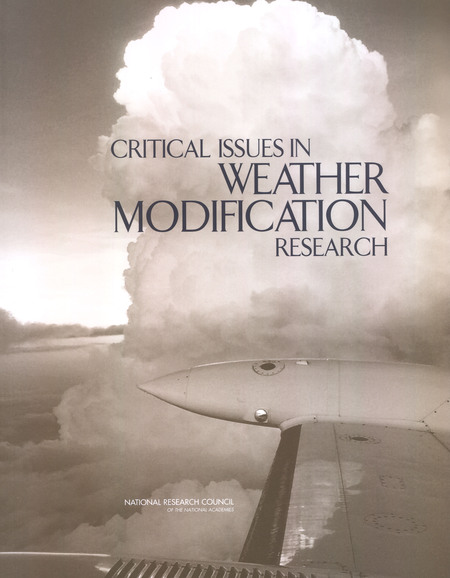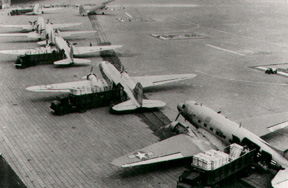Hamblin introduction
Hamblin is an environmental historian and
historian of science

This book focuses on cold war efforts to develop
environmentally damaging weapons
- how much can we use our science and
technology to control the environment for harm?
- could we develop ways to modify the
weather? should we? (note that this is a topic with
lots of conspiracy theories, such as chemtrails)
- to what extent can science give us
mastery over nature?
Background: Total
War
- just war
theory says that those making war must minimize harm
to civilians
- but in WWII one goal was to reduce
the other side's ability to build more weapons and to
demoralize the population, which meant targeting
industrial areas and civilians
- do you need more weapons than atomic
bombs? preparing the fuel for atomic bombs was slow
and so they didn't have very many
this possibility of
modifying the environment as a weapon contributed to the
way people thought about environmental issues
- scientists did research that showed
more about the vulnerability of the environment
- the military funded research on a
large scale on environmental issues
- Eugene
Odum at University of Georgia and the Savannah River
Site
this book makes
three arguments about how the cold war transformed
thinking about environmental vulnerability:
- military funded research caused
scientists to focus on environmental change and
vulnerability
- scientists came to believe that
humans now had the power to change the environment on a
large scale
- scientists saw such change as
justified by the cold war
Background: Atomic Bomb and Cold War
Atomic Bomb (now know as nuclear weapons)
- Research into the properties of the nucleus was well
under way before the war, and German
scientists made many of the key discoveries in nuclear
physics that made nuclear weapons possible
- some elements are unstable and will naturally change
to something else and release radioactivity
- Henri
Becquerel discovered radioactivity as a property of
uranium in 1896, Marie Curie
discovered other radioactive elements, but they didn't
know what was happening

Lise Meitner
- Otto
Hahn , Lise
Meitner, and O.R.
Frisch worked in the 1930s to understand the results
of bombarding uranium with neutrons--realized that the
uranium fissioned.
- by 1939 it was obvious and widely
know that a chain reaction might be possible because each
atom that fissioned released neutrons that could hit other
atoms and cause them to fission
- Refugee scientists in the U.S.
feared a German bomb. Leo Szilard composed
two letters for Einstein to sign warning President
Roosevelt of the dangers of a German atomic bomb, one in August 1939
and the other in April 1940. Fear was widespread
enough that U.S. and British journals voluntarily censored
related scientific papers.
- Germans were indeed working on a
bomb, but got stuck in a dead end. Supporters of Werner
Heisenberg say he did this on purpose.
Difficulties setting up such a big,
uncertain research and development project: the Manhattan
Project
- First organized under National
Defense Research Committee (approval for project Oct.
1941) then turned over to the army in June 1942. The
army put General Leslie
Groves in charge.
- The first thing to do was prove a
chain reaction was possible. That effort was led by
Enrico
Fermi , first at Columbia then at the University of
Chicago. The first
successful chain reaction took place Dec. 2, 1942 in
a small reactor built in a squash court at the Univ. of
Chicago.
- Providing fuel for the bomb was a
tremendous technical challenge--must separate uranium-235,
which is less than 1% of the uranium mined and differs in
weight by only .13%. Two methods of separation: a
cyclotron and gaseous diffusion of uranium hexaflouride
(the only gaseous compound, but one that is both poisonous
and corrosive) were set up at Oak Ridge
, Tenn., using TVA power. The other
alternative is to make plutonium by chain
reactions--reactors to do this were built in Hanford,
Washington.

gaseous diffusion plant at Oak Ridge, photo from fas.org
- Robert
Oppenheimer led the effort to design the bomb and
said he needed to bring scientists together at a single
laboratory. Los Alamos opened in March 1943.
Developed two bomb designs, one using uranium and one
using plutonium. The plutonium design was tested in
the Trinity
test near Alamogordo NM on July 16, 1945. Exploded
with the force of 20,000 tons of TNT.

Bombs used in Japan, photo from fas.org
The decision to drop the bomb
( good links on the
decision )
- Germany was clearly defeated and the
Japanese were retreating--was it necessary to use the
bomb? To intimidate the Soviets?
- Could there have been a
demonstration and warning instead, as some scientists
wanted? Would it have been used in Europe or was
racism a factor?
- After spending $2 billion would the
government have been accused of wasting money if it wasn't
used?
- when Roosevelt died on April 12,
1945, the bomb project was so secret that Vice President
Harry Truman didn't even know about it. The bomb was
used because having built it everyone assumed that having
built it they would use it.
- three B-29 bombers set out for Hiroshima,
Japan on Aug. 6, 1945. The Japanese sounded the
all-clear when they saw only 3 planes. The Enola Gay
dropped the 5 ton bomb and it exploded with the force of
15,000 tons of TNT. 130,000 people died within 3
months, 68% of the buildings of the city were destroyed.
- A plutonium bomb was dropped on Nagasaki
on Aug. 9, 1945. Exploded with the force of 22,000
tons of TNT.

bomb damage in Hiroshima, photo from fas.org
Does it fit the theory of just war?
The scientists tried to prevent an arms race from
developing. Why did they feel so strongly, and did they
have any hope of success?
people were shocked by the power of technology to do harm
it only took six years to turn uncertain science into a
devastating weapon
- the advance of science leads to more power
- the government has figured out how to organize
scientists to effectively produce new technologies
- science gives us power--is it going to be used for
good or harm?
- fear of the side effects of new technologies--key
example radioactivity from bombs in human milk
- technology comes to be seen as both helpful and
dangerous
The first priority was to protect the U.S.
advantage--we had nuclear weapons and the Soviet Union did not
- the bomb was a secret until it was dropped, but then
basic information was released
- some scientists thought we should share secrets as a
basis for international control of nuclear weapons
- others focused on civilian rather than military
control of US atomic research
- others worked to build more bombs and new, more
powerful kinds of nuclear weapons
The idea that the US could preserve a
nuclear monopoly was a false hope--the Soviet Union exploded
their first nuclear device in August 1949
- debate over whether to research and
build next generation bombs--the much more powerful
hydrogen bomb
- the General Advisory Committee of
the AEC (composed of scientists) studied the question
and advised a hydrogen bomb was probably possible but
should not be developed because it would do too much
harm to civilians
- the researchers and military
leaders interested in a hydrogen bomb argued that
scientists should only advise whether it was possible,
it wasn't their role to discuss whether it was a good
idea, that should be decided by political leaders
- in Jan. 1950 a crash program to
build a hydrogen bomb was approved
- one part of this was the building
of the Savannah River Site in South Carolina
- new fear about keeping secrets and
who might be a spy
- some scientists continued to push
for international control of nuclear weapons and
increasingly they were seen as a security risk
Origins of the Cold War:
- The U.S. was already afraid of
communism before World War II, but the Soviet Union was
our ally against Germany
- Communism was a competing way of
organizing society (opposed to democracy and capitalism)
that sought to expand to the rest of the world
- World War II was a new level of
total war, with key examples of purposefully killing
civilians
- Once it was clear that Germany was
falling, both countries rushed to occupy as much territory
as possible. One the reasons the U.S. used the Atom
Bomb was to end the war faster so the Soviets would not
take as much territory in Asia
- The Soviet Union wanted some control
in what it saw as buffer states, and tended to move
towards making them puppets.
- The U.S. saw this as the Soviets
moving to gradually expand
towards world dominion and developed a policy of
containment. The Truman
Doctrine (1947)--the U.S. would help the people of
free countries fighting communist takeover (either from
without or within)
- mindset--everyone has to choose
sides
- The U.S. supplied
Berlin by air (which no one was sure would be
possible) when the Soviets blockaded it in 1948 to try to
take complete control.

planes lined up for Berlin airlift
Height:
- Domino theory--fear of other
countries falling to communism
- The Red Scare of the 1950s (Joseph
McCarthy)--anyone who had had communist or disloyal
ideas was a threat to the nation and should loose their
job
- Korean
War (1950-53)
- Cuban Missile
Crisis , October
18-29, 1962. The Soviet Union was installing nuclear
missiles in Cuba. Kennedy responded by blockading
Cuba. The Soviet leader, Nikita S. Khrushchev,
authorized the firing of nuclear weapons against the U.S.
if the U.S. invaded Cuba. After several days the
Soviets agreed to remove the missiles.
- The Department of Defense got lots
of money to develop new technology because it was seen as
a wartime necessity
key issues for science
- expanding role of government
- government dependence on science for
state power (both direct and in competition for
prestige)
- rise of technocracy (government should
turn to experts instead of voters for decisions)
- military-industrial complex
- new awareness of the dangers of
scientific progress
- science and technology are more and more
mixed together






